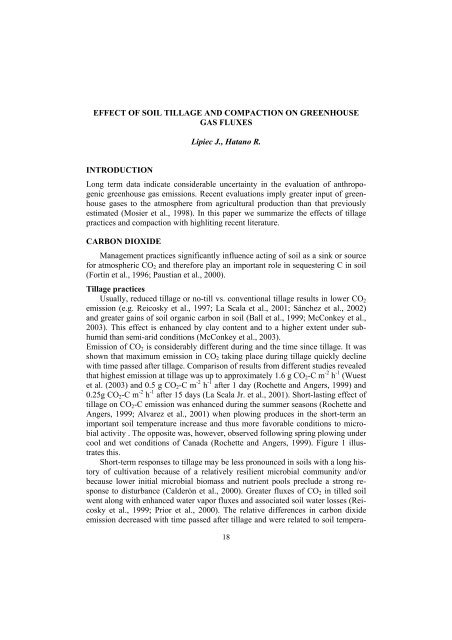soil - Lublin
soil - Lublin
soil - Lublin
Create successful ePaper yourself
Turn your PDF publications into a flip-book with our unique Google optimized e-Paper software.
EFFECT OF SOIL TILLAGE AND COMPACTION ON GREENHOUSE<br />
GAS FLUXES<br />
Lipiec J., Hatano R.<br />
INTRODUCTION<br />
Long term data indicate considerable uncertainty in the evaluation of anthropogenic<br />
greenhouse gas emissions. Recent evaluations imply greater input of greenhouse<br />
gases to the atmosphere from agricultural production than that previously<br />
estimated (Mosier et al., 1998). In this paper we summarize the effects of tillage<br />
practices and compaction with highliting recent literature.<br />
CARBON DIOXIDE<br />
Management practices significantly influence acting of <strong>soil</strong> as a sink or source<br />
for atmospheric CO 2 and therefore play an important role in sequestering C in <strong>soil</strong><br />
(Fortin et al., 1996; Paustian et al., 2000).<br />
Tillage practices<br />
Usually, reduced tillage or no-till vs. conventional tillage results in lower CO 2<br />
emission (e.g. Reicosky et al., 1997; La Scala et al., 2001; Sánchez et al., 2002)<br />
and greater gains of <strong>soil</strong> organic carbon in <strong>soil</strong> (Ball et al., 1999; McConkey et al.,<br />
2003). This effect is enhanced by clay content and to a higher extent under subhumid<br />
than semi-arid conditions (McConkey et al., 2003).<br />
Emission of CO 2 is considerably different during and the time since tillage. It was<br />
shown that maximum emission in CO 2 taking place during tillage quickly decline<br />
with time passed after tillage. Comparison of results from different studies revealed<br />
that highest emission at tillage was up to approximately 1.6 g CO 2 -C m -2 h -1 (Wuest<br />
et al. (2003) and 0.5 g CO 2 -C m -2 h -1 after 1 day (Rochette and Angers, 1999) and<br />
0.25g CO 2 -C m -2 h -1 after 15 days (La Scala Jr. et al., 2001). Short-lasting effect of<br />
tillage on CO 2 -C emission was enhanced during the summer seasons (Rochette and<br />
Angers, 1999; Alvarez et al., 2001) when plowing produces in the short-term an<br />
important <strong>soil</strong> temperature increase and thus more favorable conditions to microbial<br />
activity . The opposite was, however, observed following spring plowing under<br />
cool and wet conditions of Canada (Rochette and Angers, 1999). Figure 1 illustrates<br />
this.<br />
Short-term responses to tillage may be less pronounced in <strong>soil</strong>s with a long history<br />
of cultivation because of a relatively resilient microbial community and/or<br />
because lower initial microbial biomass and nutrient pools preclude a strong response<br />
to disturbance (Calderón et al., 2000). Greater fluxes of CO 2 in tilled <strong>soil</strong><br />
went along with enhanced water vapor fluxes and associated <strong>soil</strong> water losses (Reicosky<br />
et al., 1999; Prior et al., 2000). The relative differences in carbon dixide<br />
emission decreased with time passed after tillage and were related to <strong>soil</strong> tempera-<br />
18

















